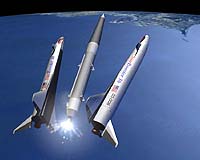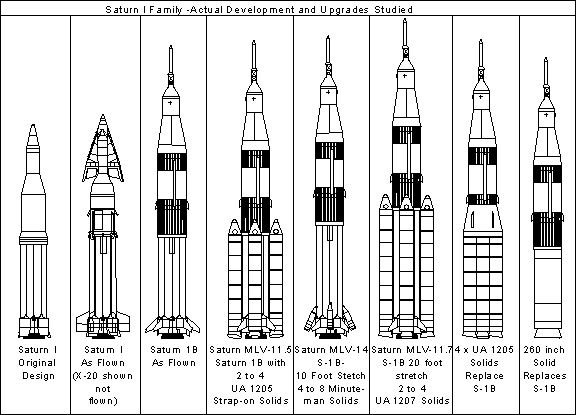New Mars Forums
You are not logged in.
- Topics: Active | Unanswered
Announcement
#29301 Re: Human missions » Cheap heavy launcher - can it be done at all » 2004-08-16 20:32:37
When I think of heavy lift I do not assume only cargo or of very large size modules. As I noted before I was referencing the need for more than a few astronauts with enough materials to maybe transfer into any such earlier launched Habitat modules.
The Progress is currently carrying to the Iss about 2.5 tons of food, water, propellant, and other supplies for its two-man crew.
How long do you think those supplies will last with a real size crew for exploration to mars or to the moon.
Just think about how many people would be on this journey and for how many months that the journey wil be fore not to mention the number of months they will be there in addition to the return trip.
If one does puny little capsulse for a max of 3. What then leave them parked in orbit for the four or 5 yearfor the round trip. I would hope not. I also do not see that many docking ports on a habitat module either. Not to mention bringing those capsules all the way to Mars or the moon, One would be bad enough.
Sorry If I am way off topic of cargo lift only.
#29302 Re: Human missions » Cheap heavy launcher - can it be done at all » 2004-08-16 14:24:48
We have talked about every thing but the manned portion of the rocket. As every one has noted it is fairly easy to design something to lift materials or other items to almost anywhere that we would want.
Man is the problem that still needs a real solution when it comes to space flight.
We could say use a capsule like; Big gemini or apollo, a small lifting body as in lockheeds concept art or from some of the x series vehicles and some would continue to say a plane format is the way to go.
We need this part of the solution today in order to retire the shuttle to only cargo mode and completion of the ISS.
I still believe that the wieght of this issue needs to be resolved by Nasa's current rocket vendors and not be issueing more contracts for what is already known to be of need.
#29303 Re: Human missions » MarsDirect or Mars Sustained ? » 2004-08-16 14:16:36
Cash flow is the only reason that we are not looking at this.
Building of the infrastucture to start the process is a must.
Finding some way to not only design a cheaper rocket but one that is less costly to operate is also a must.
#29304 Re: Human missions » Cheap heavy launcher - can it be done at all » 2004-08-16 13:53:55
Last I knew aerodynamics has to due with surface area and angles relative to direction. Hence the more surface area the more drag.
#29305 Re: Interplanetary transportation » Da Vinci in the Running - Let the Space Race Begin! » 2004-08-16 13:01:51
Try, try again: Space Transport Corp http://www.space-transport.com/ ., the Washington-based rocket team whose rocket blew up last weekend, is targeting Sept. 12 for the next test launch from the Olympic Peninsula, says Phillip Storm, the company's president.
"We’re going to fabricate two more identical Rubicon rockets. ... We're going to do another engine test in early September," Storm writes in an e-mail.
Storm says telemetry from the launch of Rubicon 1 indicates that the attitude control system "was fighting to keep it straight, even though the rocket was being torn apart."
"The rocket held in there pretty good even though one of the engines exploded," Storm writes. "I’m fairly confident a pilot could have thrown the parachute and been OK. The capsule was catastrophically damaged only on impact with the water. We’ll come up with some extra safety measures to ensure a command is sent for parachute deployment in the event of a failure."
#29306 Re: Space Policy » Space fairing Nations - The ever changing view » 2004-08-16 12:24:06
'Beagle 3' looks to American ride
http://news.bbc.co.uk/1/hi/sci/tech/3926253.stm
But even if they do not get to do another follow up mission to the failed attempt. The European Space Agency is planning its own lander mission, called ExoMars, to look for traces of life on the Red Planet. This might also launch in 2009.
#29307 Re: Human missions » Cheap heavy launcher - can it be done at all » 2004-08-16 12:03:00
Here is the other one that I had seen from the Next generation or SLI work that has been recently canned. It seems like most of the Nasa links are now gone to this info.

NASA Working with Contractors to Explore Shuttle Successor
http://dev.space.com/missionlaunches/fl_021030a.html
#29308 Re: Human missions » Cheap heavy launcher - can it be done at all » 2004-08-16 11:51:00
I could not help but notice the simularities to the Space Launch Initiative's vehicle and this one.

SLI Explores Flyback Booster Possibilities
http://www.spacedaily.com/news/rocketscience-02u.html
It is to bad that some programs have been cancelled that could have been the solution to the delma that we are in.
#29309 Re: Human missions » Rocket Business model for shuttle delta IV atlasV - and others good or bad » 2004-08-16 11:42:51
You are right if the price per unit is not effected by building by an assembly line process though automation versus by hand for a fix quantity of build. But that is just part of the problem is that high cost of build.
#29310 Re: Space Policy » Space fairing Nations - The ever changing view » 2004-08-16 10:21:42
India To Launch Recoverable Spacecraft In 2005
http://www.spacedaily.com/news/india-04l.html
#29311 Re: Human missions » Cheap heavy launcher - can it be done at all » 2004-08-16 10:07:09

To take a page out of what the Russians continued to do with their soyuz space craft. They made continued changes and enhancemens as need to keep there rockets flying and are still doing so today.
While america kept changing the rocket platform in large jumps or into other design concepts each time.
#29312 Re: Human missions » Rocket Business model for shuttle delta IV atlasV - and others good or bad » 2004-08-16 08:55:03
The intent of my thread was to give a cost based analysis as to what should be the avenue of choice. What should be the cheaper heavy lift launcher developement and manufacturing cost to create infrastructure for the future. Based on the current rockets as models for what not to do.
Large protoype design cost and over runs
Cost over runs to solidly consistant manufacturing of expendable rocket designs
Cost over runs for refurbishment of re-usable craft designs
Operations launch cost
Workfare when staff is not really working but is idle
Questions for those that know more about the Lockheed and of Boeing rockets.
Does either launch there own rockets for profit?
What is there work staff base for carrying on these facets of infrastruture?
From earlier in another thread using the RD-170 versus the F1 of the Saturn is a good choice for a first stage engine.
This sort of sound like a Saturn 1 or V re-du derivative only modernized for a business model using what is a close match for the old specification.
#29313 Re: Human missions » Cheap heavy launcher - can it be done at all » 2004-08-16 08:35:37
From earlier in the thread using the RD-170 versus the F1 of the Saturn is a good choice for a first stage engine.
This sort of sound like a Saturn 1 or V re-du derivative only modernized for a business model using what is a close match for the old specification.
#29314 Re: Science, Technology, and Astronomy » ISS cutbacks » 2004-08-16 08:05:15
The problem is that America lost it's only manned vehicle it still has others for cargo thou they like even the Russians do have there limitations as well.
Thank full yes for the Russian manned ride but angry at not paying to continue these rides is a mistake. The amount of money barely pays for the building of such rockets how could this do any harm militarily.
These are our Partners for the ISS we should not treat them any differently than what we would want to be treated. Lets be fair to each other on this accord.
#29315 Re: Human missions » Moon vs Mars? - What did President Bush intend? » 2004-08-16 07:56:51
A basic stepping stone approach was layed out in the vision but each step needs to be reviewed for we do not want lots of little expense baby steps. When larger steps are needed in order to keep the timeline of manned flight in the future nearer to our present thoughts for justification for even beginning down the road of the vision.
#29316 Re: Human missions » Cheap heavy launcher - can it be done at all » 2004-08-16 07:51:53
The intent of my other thread, Rocket Business model for shuttle delta IV atlasV, and others good or bad was to give a cost based analysis as to what should be the avenue of choice. What should be the cheaper heavy lift launcher developement and manufacturing cost to create infrastructure for the future. Based on the current rockets as models for what not to do.
Large protoype design cost and over runs
Cost over runs to solidly consistant manufacturing of expendable rocket designs
Cost over runs for refurbishment of re-usable craft designs
Operations launch cost
Workfare when staff is not really working but is idle
Questions for those that know more about the Lockheed and of Boeing rockets.
Does either launch there own rockets for profit?
What is there work staff base for carrying on these facets of infrastruture?
#29317 Re: Human missions » Hubble mistake - Action needed » 2004-08-16 07:42:02
Another issue with Hubble is not just servicing it before it is to late but one of is it more cost effective if more instruments should also fail before what we had planned force other follow up missions to keep what was just invested worth while.
#29318 Re: Human missions » Human Base on Venus - An Engineering Challenge » 2004-08-16 06:47:20
Our biggest problem with teraforming is not for lack of ideas or for the places to actually make changes to. But is more of a down to earth funding issue. One enormous expense and one not easily justified to thoughs that do not believe that man should be in space.
We need that frontiering spirit again in the hearts and mind of all before we can get enough backing to correct the funding issues. Or we need to find ways to lower the cost of doing space. This may mean changing the way of doing business when it comes to Nasa and it's contractors. The big guy's need to start trying to lower cost for there products and that would allow for more to be purchased.
#29319 Re: Human missions » Opening space to Individual or private industry - Space CHASE Act » 2004-08-16 06:41:15
I am glad that this thread has become a good discusion of what it would take to be a united Earth Space Rights conceptual thought process. But lets keep it all in a positive manner. Maybe space like Babylon 5 or of any of the Star treks is a long way off but it is the right direction to take humanity.
#29320 Re: Human missions » Cheap heavy launcher - can it be done at all » 2004-08-16 06:27:12
The case for shuttle-derived heavy lift
http://www.thespacereview.com/article/208/1
#29321 Re: Unmanned probes » Spirit & Opportunity *7* - ...continuing... » 2004-08-16 06:15:34
On another note of exploration Zoe the robot to look for life on Earth as practice for Mars once it arrives in one of the driest places on Earth, Chile's Atacama Desert. Large stretches of the Atacama, where fog is the major source of precipitation, appear devoid of life; if machines can find life in the Atacama, the thinking goes, they might have a chance of finding life on Mars, if it exists there.
#29322 Re: Human missions » Rocket Business model for shuttle delta IV atlasV - and others good or bad » 2004-08-16 06:11:09
Some would laugh at the attempt by the Privately Funded Falcon-1 Rocket Nears First Flight but I for see this as a step to get Nasa and the big guy's to start thinking of ways to lower cost access to space.
#29323 Re: Interplanetary transportation » Da Vinci in the Running - Let the Space Race Begin! » 2004-08-16 06:06:12
Canadian Ansari X Prize Entrant Takes the Plunge in Test
http://space.com/missionlaunches/xprize … 40814.html
Canadian Arrow team of rocketeers has moved one step closer to launching its own manned spacecraft with the successful parachute drop test of a crew capsule today.
#29324 Re: Space Policy » Space fairing Nations - The ever changing view » 2004-08-16 06:00:50
Nasa News Release : The Marshall Center has been selected as the site of NASA's Discovery and New Frontiers Program Office.
http://www.msfc.nasa.gov/news/news/rele … 4-214.html
What impact will this change of operations for Marshall Center have in the long run?
NASA Issues Additional Requests for Information
in Response to U.S. Space Exploration Policy Report,in response to the final report from the President's Commission on Implementation of U.S. Space Exploration Policy.
Recommendation 5-1 asks NASA to aggressively use its contractual authority to reach broadly into the commercial and nonprofit communities. Recommendation 3-1 suggests that the agency recognize and implement a far larger presence of private industry in space operations.
http://www1.nasa.gov/home/hqnews/2004/a … _rfis.html
I guess a little more detail would help poor old Nasa but do we really want Nasa leading us back into space if the can not under stand what is meant in the sections of the report.
Now I see where Nasa is really going with the change of venue for Marshall Center.
Marshall gets planet probe assignment
Center will manage, send missions for robotic explorations.
#29325 Re: Space Policy » Space fairing Nations - The ever changing view » 2004-08-16 05:48:28
Space race could prove interesting
http://www.pasadenastarnews.com/Stories....00.html
Snipet:
China sent its first astronaut into space. With Yang Liwei's 14 orbits around Earth, China became only the third country in the world to have sent a man into space.
In what U.S. officials claim was an unconnected move, four months later, President George W. Bush announced a new U.S. space policy; its goals include putting a man on the moon.
End snipet
So did Bush get scared of what the event of placing a Chinese astronaut into space had done?